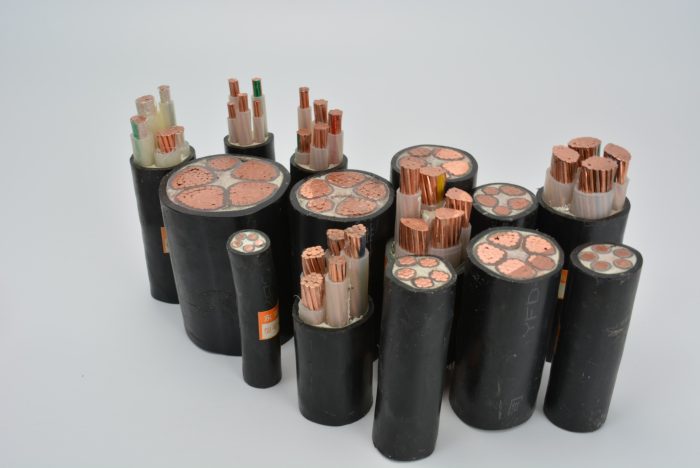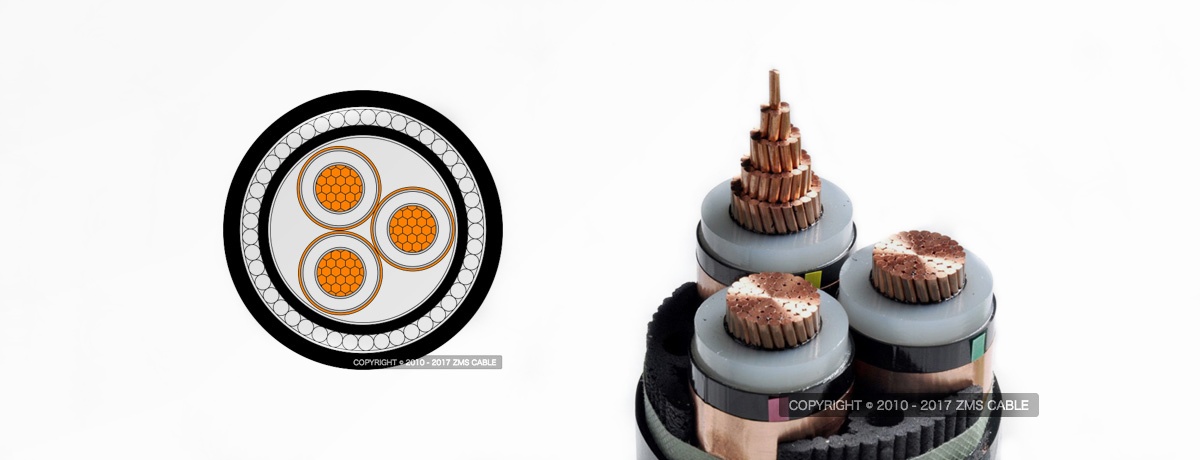

Өндөр хүчдэлийн кабелиуд нь агаарын болон далд шугамын аргаар хийгдсэн байдаг.
Өндөр хүчдэлийн зэс кабель нь цахилгаан эрчим хүчийг түгээх, дамжуулахад зайлшгүй шаардлагатай бүрэлдэхүүн хэсэг юм, бат бөх чанар, маш сайн цахилгаан дамжуулах чанарыг хоёуланг нь санал болгодог. Бүтэцийг ойлгох, Эдгээр кабелийн доторх тусгайлан тусгайлан тусгайлан тоо, янз бүрийн үйлдвэрлэлийн үйл ажиллагааг тодорхойлох нь чухал юм. Энэ нийтлэл нь хичнээн хэмжээний хүчдэлийн зэсийн кабель нь эдгээр кабелийн эдгээр кабелийн ердийн програмуудаас өөр өөр салбарт байдаг.


Горих тоонд шумбахаас өмнө, Өндөр хүчдэлийн зэс кабелийг тодруулах нь чухал юм. Эдгээр кабелийг өндөр хүчдэлд цахилгаан эрчим хүчээр дамжуулан цахилгаан эрчим хүчээр дамжуулж тусгайлан боловсруулсан болно, ерөнхийдөө хооронд 1 кВ ба 33 кВ, Хэдийгээр зарим өндөр хүчдэлийн кабелиуд нь өндөр хүчдэлийг авч чаддаг, ялангуяа дамжуулах сүлжээнд. Кабелийн цөм нь зэсээр хийгдсэн байдаг, бусад материалтай харьцуулахад илүү өндөр цахилгааны дамжуулалтыг мэддэг, өндөр хүчдэлийн системд алдартай сонголт хийх.
Өндөр хүчдэлийн зэсийн кабелийн үндсэн үүрэг бол эрчим хүчний алдагдал, аюулгүй байдлыг хангахад үр дүнтэй хүч дамжуулах чадвартай байх явдал юм. Эдгээр кабель нь ихэвчлэн бат бөх орчныг бэхэлдэг, хүрээлэн буй орчны нөхцөл байдал, цахилгаан стрессийг тэсвэрлэдэг.
Хамгийн өндөр хүчдэлийн зэсийн кабелийн нийтлэг төрөл нь нэг үндсэн кабель юм. Нэрийг санал болгож байна, Нэг үндсэн кабель нь зөвхөн нэг дамжуулагчийг агуулдаг (гол) тусгаарлагч, хамгаалалтын давхаргаар хүрээлэгдсэн. Эдгээр кабелийг янз бүрийн өндөр хүчдэлийн програмд өргөн хэрэглэгддэг, ялангуяа том хэмжээний цахилгаан дамжуулах системд.
Нэг цөмийн өндөр хүчдэлийн зэсийн кабелийн програмууд:
Нэг үндсэн кабелаас ялгаатай нь, Олон тооны үндсэн хүчдэлийн зэсийн кабель нэг гаднах бүрээс дотор олон дамжуулагч агуулсан. Эдгээр кабелийн тоо нь өөр өөр байж болно, ихэвчлэн хооронд нь хэлбэлздэг 2 руу 4, Хэдийгээр тодорхой програмууд нь илүү олон судалтай кабелийг шаарддаг. Олон цөмт кабелийг ихэвчлэн орон зай хязгаарлагдмал орчинд илүүд үздэг, тусдаа кабелийг тусдаа кабельд хийх шаардлагагүй олон цахилгаан холбоогоо нэгэн зэрэг дамжуулах боломжтой.
Хоёр цөмт кабель нь нэг цөмт хэлбэртэй харьцуулахад өндөр хүчдэлийн програмд бага түгээмэл байдаг. Гэсэн хэдий ч, Тэдгээрийг заримдаа ижил кабель дээгүүр дамжуулж өгдөг тусгай үйлдвэрлэлийн салбарт ашигладаг.
Гурван цөмт өндөр хүчдэлийн зэсийн кабелийг дунд хүчдэлийн өргөдөлд илүү их тархдаг. Гурван Cores нь гурван фазын цахилгаан дамжуулалтыг төлөөлдөг, олон үйлдвэрлэлийн систем, том хэмжээний эрчим хүчний тархалтад зайлшгүй шаардлагатай.
Гурван цөмт өндөр хүчдэлийн зэсийн кабелийн програмууд:
Дөрвөн цөмт кабелийг ерөнхийд нь дунд хүчдэлийн өргөдөлд бага ашигладаг, Хэдийгээр өндөр хүчдэлийн хувилбарууд тодорхой хэрэгцээнд зориулагдсан байдаг. Өндөр хүчдэлийн хувилбарт, Дөрөв дэх цөм нь төвийг сахисан эсвэл дэлхийн дамжуулагчаар үүрэг гүйцэтгэдэг, Системийн тохиргооноос хамаарна.
Дөрвөн үндсэн өндөр хүчдэлийн зэсийн кабелийн програмууд:
Хэд хэдэн хүчин зүйл нь өндөр хүчдэлийн зэс кабельд сонгосон цөмийн тоонд нөлөөлдөг:
Өндөр хүчдэлийн зэсийн кабелийг өргөн хэрэглэгддэг цахилгаан дамжуулах эрчим хүчний үеийн станцуудаас депризаас болон эцсийн эцэст хэрэглэгчдэд оролцдог. Тэд холын зайд их хэмжээний цахилгаан эрчим хүчийг үр ашигтайгаар шилжүүлэхэд чухал үүрэг гүйцэтгэдэг, Эрчим хүчний алдагдлыг багасгах.
Томоохон үйлдвэрлэлийн цогцолборт, Өндөр хүчдэлийн зэсийн кабелийг хүнд машин механизмд хүчээр хангахад ашигладаг, моторууд, болон нэмэлт цахилгаан ачааллыг шаарддаг бусад тоног төхөөрөмж. ЭРҮҮЛ МЭНДИЙН ЗОРИУЛСАН, ЗОРИУЛСАН ХОЛБОГДОЛЦОГЧ БОЛОМЖТОЙ БОЛОМЖТОЙ БОЛОМЖТОЙ БОЛОМЖТОЙ БОЛОМЖТОЙ.
Сэргээгдэх эрчим хүчний систем, тухайлбал салхин цахилгаан станц, нарны цахилгаан станц гэх мэт, А үеийн хүчдэлийн зэсийн кабешн дээр үеийг үндсэн цахилгаан сүлжээнд холбоход найдах. Эдгээр кабелиуд нь цэвэр энергийг холын зайнд тээвэрлэхэд зайлшгүй шаардлагатай, Энэ нь хамгийн бага алдагдалтай сүлжээнд хүрч байна.
Өндөр хүчдэлийн зэсийн кабелийг ихэвчлэн гадагшлуулах, усан доорх кабелийг хараат бус байдаг. Эдгээр кабель нь хатуу ширүүн нөхцлийг тэсвэрлэхэд хангалттай удаан эдэлгээтэй байх ёстой, үүнд чийгийг багтаана, даралт, температурын хэлбэлзэл.
Тээврийн салбар, ялангуяа төмөр зам, бас ашигладаг Өндөр хүчдэлийн зэсийн кабель дохио өгөх, хяналтын системүүд, болон цахилгаан галт тэрэгний шугамууд. Эдгээр кабель нь цахилгаан галт тэрэгний гөлгөр ажиллагааг хангах хүч чадлыг өгдөг, Трам, болон бусад өндөр хурдны төмөр замын системүүд.
Харилцаа холбоо, Өндөр хүчдэлийн зэсийн кабелийг цахилгаан станцуудтай бусад дамжуулах хэрэгслээр дамжуулан ашигладаг, мэдээллийн төвүүд, болон бусад харилцааны дэд бүтэц. Зэсийн маш сайн дамжуулалт, найдвартай байдал нь эдгээр эгзэгтэй системүүдийн хувьд хамгийн тохиромжтой сонголтыг хийдэг.
Өндөр хүчдэлийн зэсийн кабель нь янз бүрийн үндсэн тохиргоонд ирдэг, Тодорхой програм болон цахилгаан системийн шаардлагаас хамааран хамаарна. Нэг цөмт, хоёр цөмт, гурван цөмт, ба дөрвөн цөмт зэсийн кабелийг бүгд өөр өөр салбарт ашигладаг, эрчим хүч дамжуулах болон үйлдвэрлэлийн өргөдөлд хүрч, энерги, харилцаа холбоо. Тэдний олон амлалт, зэсийн дээд дамжуулалттай хослуулсан, бат бөх чанар, болон найдвартай байдал, өндөр хүчдэлийн зэсийн кабелийг орчин үеийн цахилгаан дэд бүтцэд үндсэн бүрэлдэхүүн хэсгүүдийг баталгаажуулдаг.
Том эрчим хүчний сүлжээнд хэрэглэгддэг эсэх, Аж үйлдвэрийн цогцолборууд, эсвэл сэргээгдэх эрчим хүчний төсөл, Эдгээр кабель нь дэлхийн хэмжээнд цахилгаан эрчим хүчийг үр ашигтай, аюулгүй байдлыг хангахад чухал үүрэг гүйцэтгэдэг. Өөр өөр тохиргоо, програмууд нь инженерүүд, цахилгаанчин, цахилгаанчинд тусалдаг, оновчтой гүйцэтгэл, аюулгүй байдлыг хангах.
Хүмүүс эрдэс бодисыг тусгаарлагдсан кабелийг сонсох үед, many immediately think of harsh environments like…
Харилцаа холбоо, цахилгаан дамжуулах системүүд хурдан ургадаг, the demand for reliable and cost-effective…
Том хэмжээний тос, хийн төслүүдэд, Аж үйлдвэрийн кабель нь зөвхөн дагалдах хэрэгсэл биш юм—they are the "nervous…
Цахилгаан холболтын ертөнцөд, кабелийн залгуур—кабелийн чих эсвэл кабелийн терминал гэж нэрлэдэг—байна…
Цахилгааны инженерийн төсөлд зөв резинэн кабель сонгохдоо, it is critical to…
Эрхэм хүндэт түншүүд, үйлчлүүлэгчид: 1-р сарын 29-ний өдөр, 2025 Хятадын Цагаан сарын баяр – Spring…